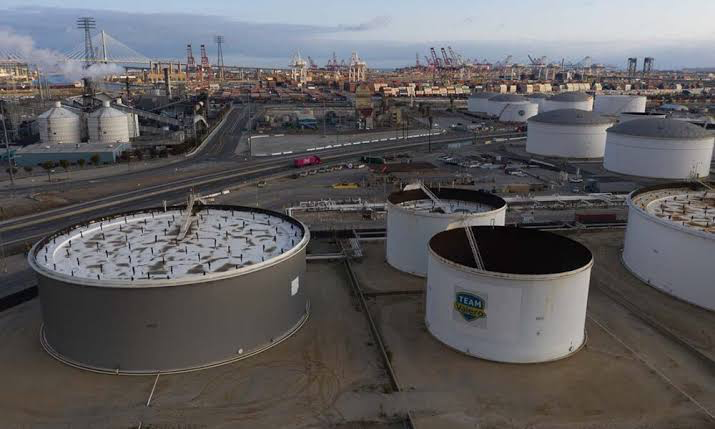163
Oil prices have surged as U.S. crude stockpiles decline and prospects for an interest rate cut improve, signaling potential economic growth. This positive outlook has revitalized the market, pushing prices higher after a recent slump.
The latest data from the U.S. Energy Information Administration (EIA) showed a significant decrease in crude oil inventories, surprising analysts who had anticipated a more modest drawdown. U.S. crude stockpiles fell by 7.5 million barrels last week, reflecting stronger demand and tighter supply.
Contributing to the market’s optimism are growing expectations of an interest rate cut by the Federal Reserve. Recent economic indicators suggest that inflation is easing, and the labor market remains robust, paving the way for a possible reduction in borrowing costs. A rate cut could stimulate economic activity, increasing demand for oil.
Brent crude futures rose 2.3% to $79.45 a barrel, while West Texas Intermediate (WTI) crude futures climbed 2.5% to $75.20 a barrel. These gains mark a rebound from the previous week’s losses, driven by concerns over global economic slowdowns and the ongoing war in Ukraine.
Analysts note that the combination of declining stockpiles and the potential for lower interest rates creates a bullish environment for oil. John Kilduff, a partner at Again Capital LLC, stated, “The significant drop in U.S. crude inventories, coupled with the possibility of a Fed rate cut, has injected new life into the oil market. Investors are optimistic that these factors will support demand.”
OPEC and its allies, collectively known as OPEC+, have also played a crucial role in stabilizing the market. The group has maintained production cuts to balance supply and demand, supporting prices. Saudi Arabia, a leading OPEC member, recently reaffirmed its commitment to these cuts, further boosting market confidence.
Despite the positive sentiment, some analysts caution that potential risks remain. Geopolitical tensions, particularly in the Middle East, could disrupt supply chains and impact prices. Additionally, the pace of global economic recovery remains uncertain, with varying impacts on oil demand.
Edward Moya, a senior market analyst at OANDA, highlighted these concerns, saying, “While the current outlook is positive, we must remain vigilant. Geopolitical risks and uneven economic growth could still pose challenges to the oil market.”
The recent market dynamics underscore the interplay between supply factors, economic policies, and geopolitical developments. As the world navigates these complexities, the oil market is likely to remain volatile, influenced by a myriad of factors.
Looking ahead, industry stakeholders are closely monitoring the Fed’s upcoming decisions and global economic indicators. The potential for a rate cut, coupled with efforts to manage supply, may provide a foundation for sustained price recovery.
In the meantime, consumers and businesses are adjusting to the fluctuating prices, with many hoping for stability in the energy sector. As the market evolves, the resilience and adaptability of industry players will be key to navigating the uncertainties ahead.
Source: Reuters
The latest data from the U.S. Energy Information Administration (EIA) showed a significant decrease in crude oil inventories, surprising analysts who had anticipated a more modest drawdown. U.S. crude stockpiles fell by 7.5 million barrels last week, reflecting stronger demand and tighter supply.
Contributing to the market’s optimism are growing expectations of an interest rate cut by the Federal Reserve. Recent economic indicators suggest that inflation is easing, and the labor market remains robust, paving the way for a possible reduction in borrowing costs. A rate cut could stimulate economic activity, increasing demand for oil.
Brent crude futures rose 2.3% to $79.45 a barrel, while West Texas Intermediate (WTI) crude futures climbed 2.5% to $75.20 a barrel. These gains mark a rebound from the previous week’s losses, driven by concerns over global economic slowdowns and the ongoing war in Ukraine.
Analysts note that the combination of declining stockpiles and the potential for lower interest rates creates a bullish environment for oil. John Kilduff, a partner at Again Capital LLC, stated, “The significant drop in U.S. crude inventories, coupled with the possibility of a Fed rate cut, has injected new life into the oil market. Investors are optimistic that these factors will support demand.”
OPEC and its allies, collectively known as OPEC+, have also played a crucial role in stabilizing the market. The group has maintained production cuts to balance supply and demand, supporting prices. Saudi Arabia, a leading OPEC member, recently reaffirmed its commitment to these cuts, further boosting market confidence.
Despite the positive sentiment, some analysts caution that potential risks remain. Geopolitical tensions, particularly in the Middle East, could disrupt supply chains and impact prices. Additionally, the pace of global economic recovery remains uncertain, with varying impacts on oil demand.
Edward Moya, a senior market analyst at OANDA, highlighted these concerns, saying, “While the current outlook is positive, we must remain vigilant. Geopolitical risks and uneven economic growth could still pose challenges to the oil market.”
The recent market dynamics underscore the interplay between supply factors, economic policies, and geopolitical developments. As the world navigates these complexities, the oil market is likely to remain volatile, influenced by a myriad of factors.
Looking ahead, industry stakeholders are closely monitoring the Fed’s upcoming decisions and global economic indicators. The potential for a rate cut, coupled with efforts to manage supply, may provide a foundation for sustained price recovery.
In the meantime, consumers and businesses are adjusting to the fluctuating prices, with many hoping for stability in the energy sector. As the market evolves, the resilience and adaptability of industry players will be key to navigating the uncertainties ahead.
Source: Reuters



